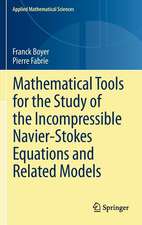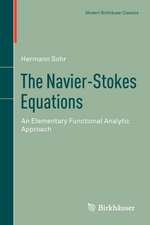Basic Theory of Ordinary Differential Equations: Universitext
Autor Po-Fang Hsieh, Yasutaka Sibuyaen Limba Engleză Hardback – 22 iun 1999
| Toate formatele și edițiile | Preț | Express |
|---|---|---|
| Paperback (1) | 536.63 lei 6-8 săpt. | |
| Springer – 24 oct 2012 | 536.63 lei 6-8 săpt. | |
| Hardback (1) | 795.68 lei 6-8 săpt. | |
| Springer – 22 iun 1999 | 795.68 lei 6-8 săpt. |
Din seria Universitext
- 13%
 Preț: 353.48 lei
Preț: 353.48 lei -
 Preț: 418.67 lei
Preț: 418.67 lei -
 Preț: 465.61 lei
Preț: 465.61 lei -
 Preț: 371.98 lei
Preț: 371.98 lei - 17%
 Preț: 394.41 lei
Preț: 394.41 lei -
 Preț: 356.77 lei
Preț: 356.77 lei - 17%
 Preț: 364.56 lei
Preț: 364.56 lei - 15%
 Preț: 543.75 lei
Preț: 543.75 lei - 15%
 Preț: 497.21 lei
Preț: 497.21 lei -
 Preț: 634.38 lei
Preț: 634.38 lei -
 Preț: 396.53 lei
Preț: 396.53 lei - 17%
 Preț: 427.68 lei
Preț: 427.68 lei - 13%
 Preț: 355.51 lei
Preț: 355.51 lei -
 Preț: 360.07 lei
Preț: 360.07 lei - 17%
 Preț: 365.34 lei
Preț: 365.34 lei -
 Preț: 358.44 lei
Preț: 358.44 lei - 15%
 Preț: 553.33 lei
Preț: 553.33 lei - 17%
 Preț: 364.81 lei
Preț: 364.81 lei -
 Preț: 673.45 lei
Preț: 673.45 lei - 15%
 Preț: 509.58 lei
Preț: 509.58 lei - 17%
 Preț: 427.32 lei
Preț: 427.32 lei - 17%
 Preț: 426.76 lei
Preț: 426.76 lei - 8%
 Preț: 495.43 lei
Preț: 495.43 lei - 20%
 Preț: 569.54 lei
Preț: 569.54 lei - 19%
 Preț: 429.21 lei
Preț: 429.21 lei - 17%
 Preț: 369.06 lei
Preț: 369.06 lei - 15%
 Preț: 737.46 lei
Preț: 737.46 lei - 13%
 Preț: 389.95 lei
Preț: 389.95 lei -
 Preț: 487.96 lei
Preț: 487.96 lei - 20%
 Preț: 628.22 lei
Preț: 628.22 lei -
 Preț: 372.86 lei
Preț: 372.86 lei -
 Preț: 319.07 lei
Preț: 319.07 lei -
 Preț: 379.86 lei
Preț: 379.86 lei -
 Preț: 445.88 lei
Preț: 445.88 lei -
 Preț: 382.36 lei
Preț: 382.36 lei - 15%
 Preț: 533.72 lei
Preț: 533.72 lei - 15%
 Preț: 496.02 lei
Preț: 496.02 lei - 15%
 Preț: 474.82 lei
Preț: 474.82 lei -
 Preț: 389.70 lei
Preț: 389.70 lei -
 Preț: 484.08 lei
Preț: 484.08 lei - 15%
 Preț: 469.41 lei
Preț: 469.41 lei - 15%
 Preț: 643.48 lei
Preț: 643.48 lei -
 Preț: 415.02 lei
Preț: 415.02 lei - 15%
 Preț: 602.25 lei
Preț: 602.25 lei - 20%
 Preț: 510.24 lei
Preț: 510.24 lei - 15%
 Preț: 588.37 lei
Preț: 588.37 lei -
 Preț: 381.59 lei
Preț: 381.59 lei -
 Preț: 489.87 lei
Preț: 489.87 lei -
 Preț: 493.89 lei
Preț: 493.89 lei
Preț: 795.68 lei
Preț vechi: 970.34 lei
-18% Nou
Puncte Express: 1194
Preț estimativ în valută:
152.25€ • 159.39$ • 125.98£
152.25€ • 159.39$ • 125.98£
Carte tipărită la comandă
Livrare economică 05-19 aprilie
Preluare comenzi: 021 569.72.76
Specificații
ISBN-13: 9780387986999
ISBN-10: 0387986995
Pagini: 469
Ilustrații: XI, 469 p.
Dimensiuni: 155 x 235 x 28 mm
Greutate: 0.84 kg
Ediția:1999
Editura: Springer
Colecția Springer
Seria Universitext
Locul publicării:New York, NY, United States
ISBN-10: 0387986995
Pagini: 469
Ilustrații: XI, 469 p.
Dimensiuni: 155 x 235 x 28 mm
Greutate: 0.84 kg
Ediția:1999
Editura: Springer
Colecția Springer
Seria Universitext
Locul publicării:New York, NY, United States
Public țintă
ResearchCuprins
I. Fundamental Theorems of Ordinary Differential Equations.- I-1. Existence and uniqueness with the Lipschitz condition.- I-2. Existence without the Lipschitz condition.- I-3. Some global properties of solutions.- I-4. Analytic differential equations.- Exercises I.- II. Dependence on Data.- II-1. Continuity with respect to initial data and parameters.- II-2. Differentiability.- Exercises II.- III. Nonuniqueness.- III-l. Examples.- III-2. The Kneser theorem.- III-3. Solution curves on the boundary of R(A).- III-4. Maximal and minimal solutions.- III-5. A comparison theorem.- III-6. Sufficient conditions for uniqueness.- Exercises III.- IV. General Theory of Linear Systems.- IV-1. Some basic results concerning matrices.- IV-2. Homogeneous systems of linear differential equations.- IV-3. Homogeneous systems with constant coefficients.- IV-4. Systems with periodic coefficients.- IV-5. Linear Hamiltonian systems with periodic coefficients.- IV-6. Nonhomogeneous equations.- IV-7. Higher-order scalar equations.- Exercises IV.- V. Singularities of the First Kind.- V-1. Formal solutions of an algebraic differential equation.- V-2. Convergence of formal solutions of a system of the first kind.- V-3. TheS-Ndecomposition of a matrix of infinite order.- V-4. TheS-Ndecomposition of a differential operator.- V-5. A normal form of a differential operator.- V-6. Calculation of the normal form of a differential operator.- V-7. Classification of singularities of homogeneous linear systems.- Exercises V.- VI. Boundary-Value Problems of Linear Differential Equations of the Second-Order.- VI- 1. Zeros of solutions.- VI- 2. Sturm-Liouville problems.- VI- 3. Eigenvalue problems.- VI- 4. Eigenfunction expansions.- VI- 5. Jost solutions.- VI- 6. Scattering data.- VI- 7. Reflectionless potentials.- VI- 8. Construction of a potential for given data.- VI- 9. Differential equations satisfied by reflectionless potentials.- VI-10. Periodic potentials.- Exercises VI.- VII. Asymptotic Behavior of Solutions of Linear Systems.- VII-1. Liapounoff’s type numbers.- VII-2. Liapounoff’s type numbers of a homogeneous linear system.- VII-3. Calculation of Liapounoff’s type numbers of solutions.- VII-4. A diagonalization theorem.- VII-5. Systems with asymptotically constant coefficients.- VII-6. An application of the Floquet theorem.- Exercises VII.- VIII. Stability.- VIII- 1. Basic definitions.- VIII- 2. A sufficient condition for asymptotic stability.- VIII- 3. Stable manifolds.- VIII- 4. Analytic structure of stable manifolds.- VIII- 5. Two-dimensional linear systems with constant coefficients.- VIII- 6. Analytic systems in ?n.- VIII- 7. Perturbations of an improper node and a saddle point.- VIII- 8. Perturbations of a proper node.- VIII- 9. Perturbation of a spiral point.- VIII-10. Perturbation of a center.- Exercises VIII.- IX. Autonomous Systems.- IX-1. Limit-invariant sets.- IX-2. Liapounoff’s direct method.- IX-3. Orbital stability.- IX-4. The Poincaré-Bendixson theorem.- IX-5. Indices of Jordan curves.- Exercises IX.- X. The Second-Order Differential Equation$$\frac{{{d^2}x}}{{d{t^2}}} + h(x)\frac{{dx}}{{dt}} + g(x) = 0$$.- X-1. Two-point boundary-value problems.- X-2. Applications of the Liapounoff functions.- X-3. Existence and uniqueness of periodic orbits.- X-4. Multipliers of the periodic orbit of the van der Pol equation.- X-5. The van der Pol equation for a small ?> 0.- X-6. The van der Pol equation for a large parameter.- X-7. A theorem due to M. Nagumo.- X-8. A singular perturbation problem.- Exercises X.- XI. Asymptotic Expansions.- XI-1. Asymptotic expansions in the sense of Poincaré.- XI-2. Gevrey asymptotics.- XI-3. Flat functions in the Gevrey asymptotics.- XI-4. Basic properties of Gevrey asymptotic expansions.- XI-5. Proof of Lemma XI-2-6.- Exercises XI.- XII. Asymptotic Expansions in a Parameter.- XII-1. An existence theorem.- XII-2. Basic estimates.- XII-3. Proof of Theorem XII-1-2.- XII-4. A block-diagonalization theorem.- XII-5. Gevrey asymptotic solutions in a parameter.- XII-6. Analytic simplification in a parameter.- Exercises XII.- XIII. Singularities of the Second Kind.- XIII-1. An existence theorem.- XIII-2. Basic estimates.- XIII-3. Proof of Theorem XIII-1-2.- XIII-4. A block-diagonalization theorem.- XIII-5. Cyclic vectors (A lemma of P. Deligne).- XIII-6. The Hukuhara-Turrittin theorem.- XIII-7. An n-th-order linear differential equation at a singular point of the second kind.- XIII-8. Gevrey property of asymptotic solutions at an irregular singular point.- Exercises XIII.- References.
Recenzii
"This book in pure mathematics will guide the reader on a newly marked path through classic and awesome terrain---first so well described by Coddington and Levinson---toward research in the important and useful areas of power series solutions and asymptotics. The path not taken would be marked by at least one explicit mention of a Poincaré map, a resonance in celestial mechanics, an average, a traveling wave, or a transversal intersection of separatrices."--MATHEMATICAL REVIEWS












